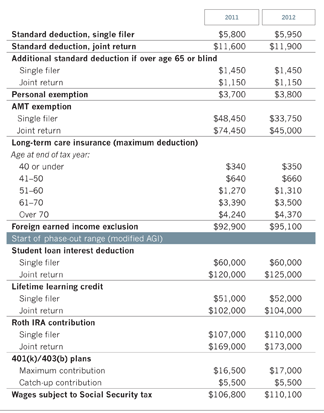The standard deduction, personal exemption and certain other figures the Internal Revenue Service adjusts for inflation will take their biggest jump in three years in 2012. But some items that are indexed for inflation won't change at all, while a few coveted breaks will actually shrink next year with changes in the law.
Items subject to indexing don't always change because there are often minimum adjustment amounts, and in some cases there hasn't been enough inflation to bump the figure to the next level, says Mark Luscombe, principal federal tax analyst at CCH Inc., an information publisher in Riverwoods, Ill. That applies to the annual gift tax exclusion, which only rises in thousand-dollar increments. It remains at $13,000 for 2012.
An increase in the lifetime exemption from the gift and estate tax to $5,120,000 in 2012, up from $5 million per individual this year, gives wealthy clients the opportunity to make more tax-free gifts, says Katie Colombo, an attorney at Oshins & Associates LLC, in Las Vegas. A married couple can gift an additional $240,000 next year without triggering federal gift tax even if both spouses have used the full exemption currently available to each of them, Colombo says.
The highest ordinary bracket, 35%, starts at taxable income of $388,350 in 2012 on both single and joint returns, versus $379,150 this year. Taxpayers whose ordinary tax bracket is 15% or lower pay no tax on qualified dividends and long-term capital gains. In practical terms, that means in 2012 married couples can have taxable incomes of as much as $70,700, and singles as much as $35,350, before their dividends and long-term gains are taxed. That's up from 2011's $69,000 and $34,500, respectively.
But the news isn't all rosy. For individuals, the exemption from alternative minimum tax is scheduled to take a precipitous drop next year with the expiration of a provision of the 2010 Tax Relief Act. For business owners, Section 179 expensing will be capped at $139,000, down dramatically from 2011's $500,000 limit. And the deduction will begin to phase out when a business purchases more than $560,000 of qualifying assets.
The IRS announced many 2012 figures in Rev. Proc. 2011-52, at http://www.irs.gov/pub/irs-drop/rp-11-52.pdf.
-Eric L. Reiner
chart

Investors Can Change Irrational Behavior
Investors often have tendencies to do irrational, stupid things.
But irrational investor behavior can be changed, say experts in behavioral finance, so that people eventually learn to act in their own long-term best interest.
Dr. Russell James III, a behavioral finance expert, said at a Napfa conference in New York in October that there is a neurological basis for financial decisions. James, an associate professor in the division of personal financial planning at Texas Tech University, presented findings along with Donald Duncan, the founding partner of D3 Financial Counselors LLC in Downers Grove, Ill., and a board member of the Midwest Napfa Region.
"It's important to understand behavioral concepts so we as planners can better serve clients," Duncan said. He added that better judgment of client reactions to risk and loss scenarios can help planners identify behavioral biases and develop appropriate alternatives to recommend investments more appropriate to each client.
"The planner can either change the client's perspective to reflect reality or change the recommendations to match the client's perspective," Duncan said.
James told the audience that once investors understand the underlying causes of their actions, they can then create a framework or a future concept of the same event that may be more advantageous and help them better achieve their goals. He outlined what in behavioral science is known as a "dual self" model or approach to maximize rational decision-making.
Studies by Harvard University professor Drew Fudenburg and David K. Levine of Washington University suggest that many sorts of decision problems should be viewed as a game between a sequence of impulsive short-run actions and more patient longer-term actions.
In the first action, investors are concerned with one brief period and in the second, with the "lifetime utility" of their actions, James said. By applying this theory, it's possible for investors to change their current perception of an event to a future concept of the same event, which might produce more rational decision-making to facilitate better outcomes.
The second application of this theory involves the use of pre-commitment investment strategies where investors commit in advance to a financial agreement, circumstance or product that can help them accomplish their financial goals. Such behavior might lead to holding more illiquid assets like real estate, or making stronger commitments to save money.








